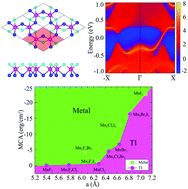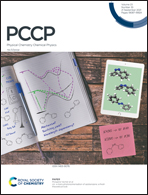The Dirac half-semimetal and quantum anomalous Hall effect in two-dimensional Janus Mn2X3Y3 (X, Y = F, Cl, Br, I)†
Abstract
The quantum anomalous Hall (QAH) effect has been experimentally observed in magnetically-doped topological insulators. However, the QAH effect is only seen at extremely low temperatures due to the weak magnetic coupling, small band gap and low carrier mobility. Here, based on first-principles density functional theory, we predict that the Janus Mn2X3Y3 (X, Y) = F, Cl, Br, I are high Curie temperature ferromagnets. Furthermore, we find that they are Dirac half-metals characterized by a Dirac cone in one spin channel with carrier mobilities comparable to freestanding germanene and a large band gap in the other spin channel except for Mn2F3I3. Simultaneously, when the spin–orbital coupling interaction is considered, the Janus Mn2F3Cl3, Mn2Cl3Br3, and Mn2Br3I3 exhibit a nontrivial band gap, indicating that they host a QAH phase. More interestingly, both the Chern number sign and the chiral edge current are tuned by changing the direction of magnetization. Moreover, we find that topological properties are related to the lattice constant and magnetocrystalline anisotropy. Our findings would suggest the possibility of not only realizing the QAH effect but also designing the flow direction of the edge current.



 Please wait while we load your content...
Please wait while we load your content...